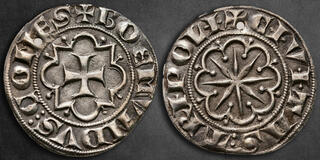| Savoca Numismatik GmbH & Co. KG > Online Auction 198 | Silver | Auction date: 25 February 2024 |
| Lot number: 323 Price realized: 170 EUR (Approx. 184 USD) Note: Prices do not include buyer's fees. | Show similar lots on CoinArchives Find similar lots in upcoming auctions on |
| Lot description: Crusaders. Tripoli (County). Bohemond VI AD 1251-1275. Groš AR 24 mm, 2,92 g ✠ BOEMVNDVS⁝COMES, cross within frame of alternate arcs and angles / ✠ CIVITAS⁝TRIPOLI, eight-pointed star within eight arcs. Well struck and beautifully toned. About Extremely Fine, Pierced. CCS 22. Metcalf, Crusades, 490. Wäckerlin 61. The practice of wearing coins as adornments or amulets among the Crusaders is a testament to the deep intertwining of faith, identity, and material culture during the medieval period. These coins, minted in the Crusader states within the Levant, transcended their primary function as mediums of economic exchange, embodying profound symbolic meanings. For the Crusaders, these pieces were not merely currency but potent symbols of their devout Christianity, their allegiance to feudal lords, and their sacred commitment to the Crusades. In an era where the pilgrimage to the Holy Land and the defense of Christendom were considered divine duties, the imagery and inscriptions on these coins-be it crosses, saints, or other Christian symbols-served as constant reminders of the wearer's faith and the divine protection it purportedly offered. This belief transformed these coins into talismans, cherished by Crusaders who saw in them a spiritual safeguard against the adversities of battle or the hardships encountered on their journey. Beyond their devotional significance, these coins were also emblematic of the wearer's identity and political affiliations. In the politically fragmented and often internally contentious environment of the Crusader states, showcasing one's allegiance through the wearing of a specific ruler's coinage was a powerful statement of loyalty. It reinforced social and military bonds among the Crusaders, serving as a visible badge of unity and shared purpose in a foreign land fraught with peril and opposition. Wearing these coins also signaled economic and social status. In a time when precious metals signified wealth, adorning oneself with silver or gold coins was a clear indication of one's standing within the Crusader society. This practice mirrored broader medieval norms where material wealth was frequently displayed as a marker of social distinction. Moreover, the Crusades were a crucible of cultural exchange between the East and West, with the practice of wearing coins likely influenced by local traditions encountered by the Crusaders in the Levant. This blending of customs reflects the broader syncretism that characterized the Crusader states, where Western and Eastern influences merged in various aspects of life. Thus, the act of wearing coins among the Crusaders was a multifaceted expression of personal and collective identity. It wove together strands of religious devotion, political loyalty, and social prestige, embedded within the broader tapestry of cultural interaction that defined the Crusader presence in the Holy Land. These coins, when worn, were a tangible manifestation of the wearer's beliefs, allegiances, and aspirations, linking them to a cause that transcended geographical and temporal boundaries. Today, these coins continue to offer invaluable insights into the Crusader ethos, revealing the complex interplay of motives and identities that drove these medieval warriors and pilgrims Starting price: 100 EUR |  |


